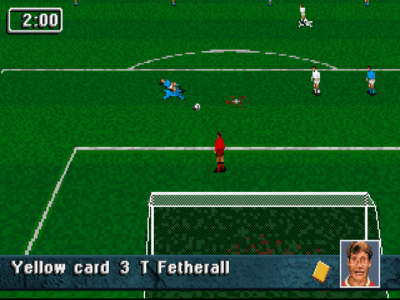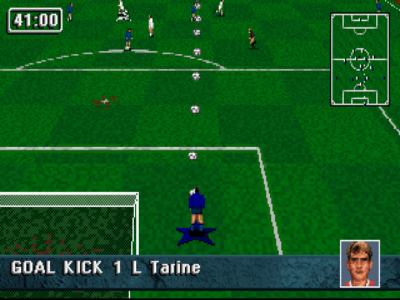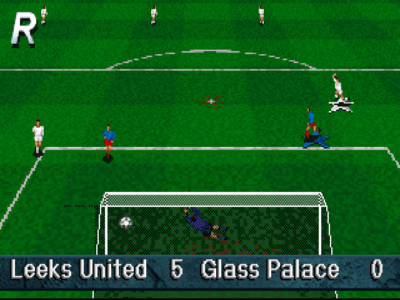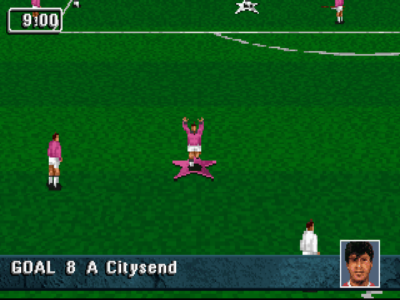
Striker ’95
Written by: Rik
Date posted: March 3, 2016
- Genre: Sport
- Developed by: Rage Software
- Published by: Time Warner Interactive
- Year released: 1995
- Our score: 3
The original Striker was both quite good and moderately successful. In the world of football games, that’s enough to earn you a seasonal update, the aim of which should hopefully be to build upon what the previous iteration did well, address significant faults, and add a few bells and whistles.
Striker ’95, though, is a very curious affair. It’s recognisably related to the original, in that it adopts the same (slightly misguided) pitch view, but also seems to have suffered from the worst kind of 90s multimedia makeover imaginable. The in-game graphics have a weird raggedy quality and lurch around unpredictably, in a way that might once have been superficially impressive to people from the 90s, but now looks extremely silly. It’s the kind of football game you could imagine having been released on the Phillips CD-i (sorry, CD-i fans, but you know what I mean).
Other new features include an extremely sparse selection of in-game comments from Andy “stick your hands down here, love” Gray – a high-profile but slightly strange choice, given that his fame was achieved as a summariser rather than commentator. A wider selection of teams – including club sides – are available, although unlike the original Striker, real player names are not used. (It was traditional in the 90s for football games without the requisite licences to use ‘humorous’ alternatives, so fans of my team from West Yorkshire can play as Leeks United, while at international level, England’s goalkeeper is one David Seawoman).
A couple of other bizarrely retrograde steps in this area are that the kit editor doesn’t seem to allow for stripes or hoops, so all teams play in plain colours, while the potential for tactical tinkering is undermined by the fact that player stats can no longer be viewed in the pre-match tactics screen, only while editing the squads.
There’s also now an indoor mode, if playing 11-a-side indoor matches appeals (this was another brief trend in 90s footy games). I imagine if you want indoor football you’d expect more than a change of graphics and a wall around the pitch, which is pretty much all that’s on offer here.
On the field, the problem of getting ‘hemmed in’ by good teams has been solved by a) making the default kick more hefty, allowing defenders to clear more easily, and b) lowering the difficulty level to make the game so easy you never have to worry about the opposition. If we generously count that a positive (which it isn’t), almost everything else about Striker ’95 is worse than in Striker.
In an attempt to add an extra dimension to the admittedly frenetic one-paced action previously on offer, a second button has been added to the control scheme, providing a speed boost for your players, and an option to pass when pressed in conjunction with the shoot/kick button. The pass doesn’t work. Your player will do what looks like a very deliberate passing movement – the kind you might effect if the ball from some nearby kids’ game rolled your way and you wanted to kick it back in a manner that suggested you’d ‘played a bit’ – only for the ball to go absolutely nowhere near a teammate. The timing of the auto player select is a bit off, which doesn’t help (in this, or several other areas) but you’ll be lucky to pull off a single successful pass.
While the original Striker wasn’t exactly suited to a cultured passing game, there was a system of sorts which, despite the one-button control scheme, allowed you at least to move the ball in the general direction of your other players. In Striker ’95, with the introduction of the completely useless pass feature, the power level of the other kick has been increased so that it can only be used for booting it upfield or shooting towards goal.
Volleys and headers also don’t work as they did, and your players now launch into a sliding tackle when you want to connect with a cross or rebound. Slides, incidentally, are ludicrous, launching your players 20 yards or so, sometimes taking out not just one but two players in the process. So your tactics are basically just to run with the ball and blast it towards goal whenever possible. Adding bend to your shots is a little tricky, but, as in the previous game, it doesn’t matter too much. Angled efforts from a distance are the way to go – while ‘keepers can pull off some unlikely saves at short range, they’re also flummoxed by anything weak that dribbles slowly along the ground from several miles away.
As mentioned, the graphics aren’t much cop – the cartoony simplicity of the original has aged more gracefully – and the Andy Gray commentary is brief and non-specific (he just spouts inconsequential clichés such as “looking for the big man up front” which is particularly nonsensical given your inability to perform headers). Without making any assumptions about from where you might source your old games, the version most commonly available is not the full CD release, so you’re spared the prospect of watching a variety of in-game video clips.
Watching blurry video of a real-life football player taking a throw in just because you are about to do so yourself would be rather pointless, and that’s a running theme for most of Striker ’95’s sundry additions, like the ability to edit the portraits of players which are displayed at various points when the ball goes out of play: they’re so pixelated, it’s hard to make out what each one supposedly looks like, but it also has no bearing on their on-pitch sprite’s appearance (not, for example, hair or skin colour) so I’m not sure why anyone would bother. Or there’s the description of each (fake) stadium, with meaningless statistics for capacity and attendance, which have precisely zero noticeable effect once you’re into the match.
You’d think the effort expended in these areas could have been more usefully directed elsewhere, towards things people actually care about, such as (off the top of my head): displaying who is actually in possession of the ball, keeping track of players’ appearances and goals across a tournament, or just making the actual game better.

When players are tackled, they roll around grabbing their genitals. Or at least, that’s what it looks like.
The best thing that can be said for Striker ’95 is that I did find it rather funny in places. That’s not funny as in a hilarious ‘so bad it’s good’ kind of way, but more that vaguely daft things keep happening throughout the course of match and, no matter how determined you might be to take it seriously, it’s impossible to do so. (I suppose the fact you’re extremely likely to be winning the match at the time allows you to be relatively sanguine about such things).
Striker ’95 is pretty terrible. It’s not completely unplayable, but its existence deserves no more than a cursory acknowledgement. You can see the roots of the original beneath the naff CD-ROM re-skin and various glitches, but it’s laughable to think that anyone considered this an improvement.





 Posts
Posts